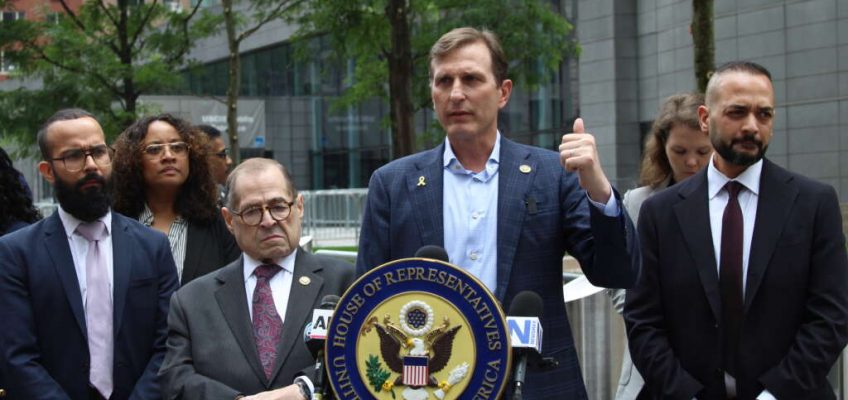The legislation would get rid of Biden-era federal tax incentives that made solar and wind projects more affordable, and kills residential tax incentives for homeowners making energy efficiency upgrades.
Trump at a press briefing last week. (Official White House Photo by Molly Riley)
President Donald Trump’s long awaited “Big Beautiful Bill,” which passed the U.S. Senate on a narrow 51-to-50 margin on Tuesday and now seeks the House’s approval, could have ugly repercussions for New York’s clean energy transition, experts say.
Starting in 2027, the legislation would get rid of Biden-era federal tax incentives that made it more affordable for companies to generate clean energy out of solar and wind projects in New York.
The bill also nixes a consumer tax credit that makes it cheaper to buy electric vehicles, and kills residential tax incentives that drive down electricity bills for homeowners by subsidizing energy efficiency upgrades.
Environmental advocates see the bill as yet another roadblock imposed by the Trump administration to stall the state’s attempts to build out its green economy. Trump already tried to derail the construction of a New York-based offshore wind project and suspended new leasing and permitting for wind projects altogether.
“This bill could blow a hole through the heart of [New York’s] clean energy economy,” said Robert Freudenberg, vice president of the Regional Plan Association’s energy and environmental programs.
Solar power panels on the roof of a co-op building in the Bronx. (Photo by Adi Talwar)
What’s in the bill?
Trump’s “Big Beautiful Bill,” which slashes taxes and social safety net programs, mainly targets Medicaid and food stamps.
But it also includes provisions to get rid of environmental tax incentives specifically targeted at the wind and solar industry, which the president has repeatedly expressed a personal disdain for.
He has complained over the years that wind turbines ruined the view from his golf course in Scotland and told a room full of oil and gas executives on the campaign trail that he “hates” wind. Trump made similar comments about solar, claiming the panels are “ugly as hell.”
Trump’s bill gets rid of the $500 billion package known as the Inflation Reduction Act (IRA) that the Biden administration put in place to, among other things, bolster the green economy and tackle global warming. The IRA’s environmental fund, most of which has already been spent, was referred to by former vice president Kamala Harris as “largest investment ever to take on the climate crisis.”
The residential tax credits baked into the IRA helped reduce the carbon footprint of individual buildings by giving homeowners funds for weatherization, or a wide variety of environmentally friendly upgades to their homes. That includes putting up solar panels, buying heat pumps, electric stoves or insulating properties to retain energy instead of wasting it.
“By encouraging people to do these upgrades they lowered their energy usage, which put more energy on the grid and drove down the costs of their utility bills,” said Matt Salton, federal policy manager at the New York League of Conservation Voters (NYLCV).
In 2022, over 150,000 New Yorkers took advantage of the residential tax credits and a year later nearly 200,000 used the incentive, according to the environmental group.
If Trump’s bill makes it through, these credits will end starting in 2026.
The “Big Beautiful Bill” also makes it harder for companies to build out clean energy capacity, axing a federal tax incentive that made constructing solar and wind projects more affordable.
“These tax credits going away will make those projects exponentially more expensive,” said Rob Rains, an energy and environmental policy analyst at the D.C-based firm Washington Analysis.
If it becomes too costly and uncertain to invest in solar and wind in New York, developers could pull out of ongoing projects and new investors could shy away from building out renewables in the state, Rains explains.
While the bill removes the federal tax credits for wind and solar projects starting in 2027, it does include some caveats, experts who analyzed the bill told City Limits.
Wind and solar projects that start construction within one year of the bill becoming law can still claim the tax cuts, but have up to four years to complete construction. For companies that begin construction after that, their projects must be placed in service by the end of 2027 to use the credits.
Gov. Kathy Hochul at a 2022 press conference, marking start of construction of New York’s first offshore wind project. (NYS Governor’s Office)
Another obstacle
Regardless of the caveats, environmental advocates agree the bill would be another setback for New York’s shift to cleaner energy. Trump already enacted a series of measures this year that stall the transition away from fossil fuels.
The administration suspended new leasing and permitting for wind projects across the United States. Trump has also pushed to revive fossil fuel projects that New York previously rejected, like the Constitution Pipeline, a major venture by the Williams company to transport planet-warming fracked gas from Pennsylvania to New York City.
But even before Trump took office, New York was failing to keep up with the ambitious goals set by the state’s landmark climate law.
Benchmarks laid out in the Climate Leadership and Protection Act (CLCPA)—which requires the state to mostly phase out the use of fossil fuels by 2030—have already been pushed back by three years.
“Despite New York enacting among the most aggressive decarbonization policies in the nation, clean energy buildout in the Empire State has historically been slow,” said Timothy Fox, managing director at the consulting firm Clear View Energy.
Although the clock is ticking to reach the CLCPA’s targets, only about 29 percent of the Empire State’s electricity currently comes from renewable sources.
The “Big Beautiful Bill” does include carve outs for developers that want to generate zero-emission electricity like nuclear, geothermal or hydropower. But energy experts say leaving out other sources of renewable energy will knee cap progress already underway for over a decade.
“Billions of dollars have been spent to build out wind and solar. So this [bill] is basically tilting the scales against building out more clean energy,” Freudenberg pointed out.
“It threatens the multiple benefits of the clean energy industry including cleaner air, more good paying jobs and reducing the impacts of climate change,” he added.
To reach the reporter behind this story, contact Mariana@citylimits.org. To reach the editor, contact Jeanmarie@citylimits.org
Want to republish this story? Find City Limits’ reprint policy here.
The post What Would Trump’s ‘Big Beautiful Bill’ Mean for New York’s Green Transition? appeared first on City Limits.




